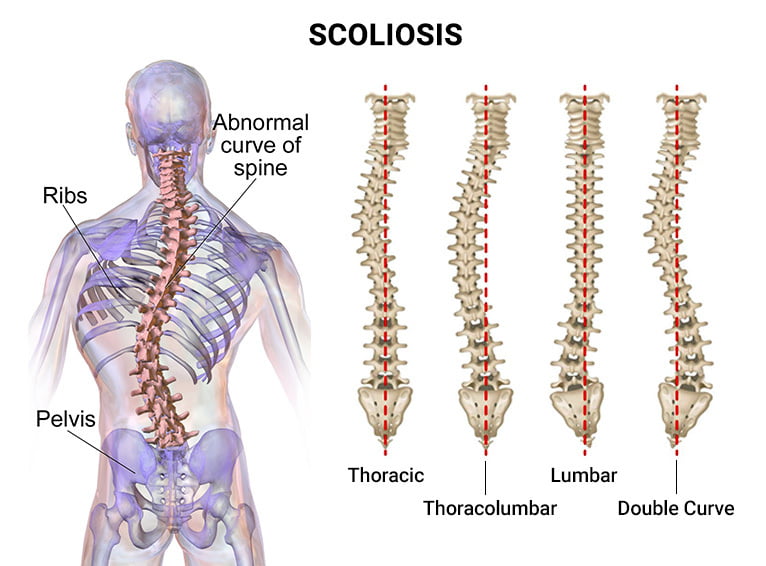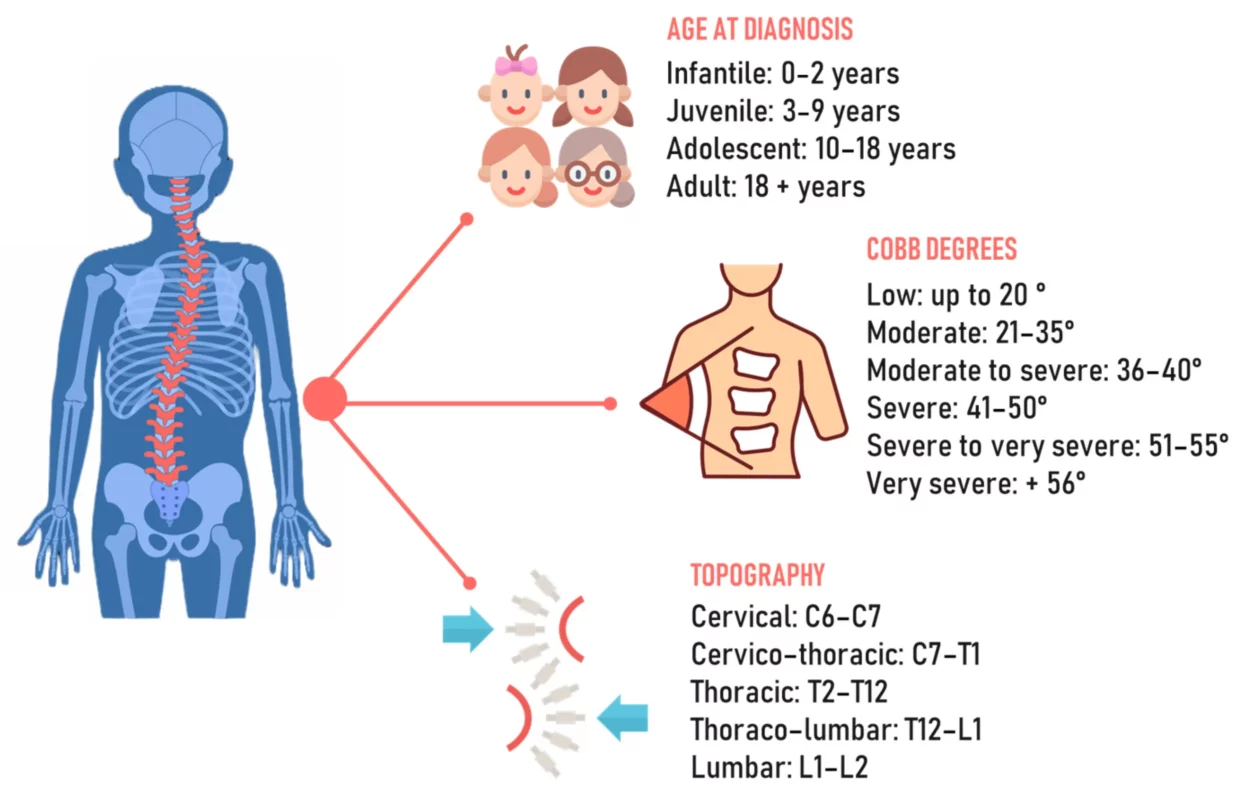Antes de profundizar en los factores de riesgo de la escoliosis, es importante comprender la curvatura normal de la columna vertebral. La columna tiene curvas naturales que ayudan a mantener el equilibrio y absorber los impactos. Estas curvas incluyen la curva cervical (cuello), la curva torácica (parte superior de la espalda), la curva lumbar (parte inferior de la espalda) y la curva sacra (pelvis). Vista de lado, la columna vertebral debe parecer recta. Sin embargo, vista desde atrás, debe tener una suave curvatura en forma de "S". Cualquier desviación de esta curvatura normal puede indicar la presencia de escoliosis.

Tipos y causas de la escoliosis
La escoliosis puede clasificarse en distintos tipos en función de su causa y edad de aparición. Los tipos más comunes son la escoliosis idiopática, la congénita y la neuromuscular. La escoliosis idiopática, que representa aproximadamente el 80% de los casos, no tiene causa conocida. La escoliosis congénita se presenta al nacer y está causada por un desarrollo anormal de la columna vertebral en el útero. La escoliosis neuromuscular está asociada a afecciones neuromusculares subyacentes como la parálisis cerebral o la distrofia muscular ([1]).

Factores genéticos y escoliosis
La genética desempeña un papel importante en el desarrollo de la escoliosis. Las investigaciones han demostrado que las personas con antecedentes familiares de escoliosis tienen más probabilidades de desarrollar la enfermedad. Según la Scoliosis Research Society, si un familiar de primer grado (padre, hermano o hijo) tiene escoliosis, el riesgo de desarrollarla aumenta en 20% ([2]). Además, se han identificado mutaciones genéticas específicas en algunos casos de escoliosis, lo que sugiere un componente genético de la enfermedad ([3]).
Edad y riesgo de escoliosis
La edad es otro importante factor de riesgo de la escoliosis. Aunque la escoliosis puede desarrollarse a cualquier edad, lo más frecuente es que se diagnostique durante la adolescencia, entre los 10 y los 18 años. Es lo que se conoce como escoliosis idiopática del adolescente (EIA). El riesgo de desarrollar AIS aumenta durante los periodos de crecimiento rápido, como la pubertad. Se calcula que entre el 2 y el 4% de los adolescentes padecen AIS, y que las chicas se ven afectadas con más frecuencia que los chicos ([4]).

Sexo y escoliosis
El sexo también es un importante factor de riesgo de escoliosis. Las chicas tienen más probabilidades de desarrollar escoliosis que los chicos, con una proporción aproximada de 2:1 ([5]). La razón de esta disparidad de género no se conoce del todo, pero las diferencias hormonales y esqueléticas entre hombres y mujeres pueden desempeñar un papel. El mayor riesgo en las chicas pone de relieve la importancia de las revisiones periódicas de escoliosis, especialmente durante la adolescencia ([6]).
Antecedentes familiares y escoliosis
Como ya se ha mencionado, tener antecedentes familiares de escoliosis aumenta el riesgo de padecerla. Si un pariente cercano tiene escoliosis, es importante estar atento y vigilar cualquier signo o síntoma. Las revisiones periódicas y la detección precoz pueden ayudar a prevenir la progresión de la escoliosis y minimizar la necesidad de tratamientos invasivos ([7]).
Brotes de crecimiento y escoliosis
Durante los periodos de crecimiento rápido, como los estirones en la adolescencia, aumenta el riesgo de desarrollar escoliosis. La columna vertebral crece rápidamente durante estos periodos, y cualquier desequilibrio o anomalía puede provocar la aparición de escoliosis. Es fundamental vigilar de cerca a los niños y adolescentes durante los estirones y buscar atención médica si se observa algún signo de escoliosis ([8]).
Desequilibrios musculares y escoliosis
Los desequilibrios musculares pueden contribuir al desarrollo de la escoliosis. Los músculos débiles o desequilibrados de la espalda, el abdomen o la pelvis pueden provocar una curvatura anormal de la columna vertebral. Por ejemplo, unos músculos centrales débiles pueden no proporcionar un apoyo adecuado a la columna, provocando una curvatura. El ejercicio regular, sobre todo los ejercicios que fortalecen los músculos centrales y de la espalda, pueden ayudar a prevenir los desequilibrios musculares y reducir el riesgo de escoliosis ([9]).
Postura y riesgo de escoliosis
Las malas posturas suelen asociarse a un mayor riesgo de desarrollar escoliosis. Estar encorvado o sentado en una posición encorvada durante periodos prolongados puede sobrecargar la columna vertebral y provocar desequilibrios. Es importante mantener una buena postura, tanto sentado como de pie, para reducir el riesgo de desarrollar escoliosis. Los ajustes ergonómicos en el entorno laboral y doméstico también pueden ayudar a promover una postura y una alineación de la columna adecuadas ([10]).
Factores profesionales y de estilo de vida
Ciertos factores laborales y de estilo de vida pueden aumentar el riesgo de desarrollar escoliosis. Por ejemplo, las personas que realizan actividades que implican movimientos asimétricos repetitivos, como llevar mochilas pesadas sobre un hombro o practicar deportes unilaterales, pueden ser más propensas a desarrollar escoliosis. Además, las personas con estilos de vida sedentarios o las que pasan muchas horas sentadas o de pie en una misma posición pueden tener un riesgo mayor. Es importante tener en cuenta estos factores y realizar los ajustes necesarios para reducir el riesgo de escoliosis ([11]).
Detección precoz y prevención de la escoliosis
La detección precoz es crucial para tratar eficazmente la escoliosis. Las revisiones periódicas, especialmente durante los periodos de crecimiento rápido, pueden ayudar a identificar la escoliosis en una fase temprana, cuando es más tratable. El método de cribado más habitual es la prueba de inclinación hacia delante de Adam, en la que la persona se inclina hacia delante mientras el médico examina la columna para detectar cualquier signo de curvatura. Si se detecta escoliosis, pueden recomendarse otras pruebas diagnósticas, como radiografías o resonancias magnéticas ([12]).
La prevención de la escoliosis implica abordar los factores de riesgo mencionados anteriormente. Mantener una buena postura, hacer ejercicio con regularidad para fortalecer los músculos centrales y de la espalda y evitar los movimientos asimétricos repetitivos pueden ayudar a reducir el riesgo de desarrollar escoliosis. Además, las personas con antecedentes familiares de escoliosis deben estar atentas y buscar atención médica si observan algún signo o síntoma ([13]).
En conclusión, identificar los factores de riesgo de la escoliosis es esencial para la detección precoz y la prevención. Los factores genéticos, la edad, el sexo, los antecedentes familiares, los estirones, los desequilibrios musculares, la postura y los factores laborales y de estilo de vida contribuyen a la probabilidad de desarrollar escoliosis. Conociendo estos factores de riesgo y tomando las medidas adecuadas, las personas pueden reducir el riesgo de desarrollar escoliosis y garantizar una salud óptima de la columna vertebral. Las revisiones periódicas y la intervención precoz son fundamentales para tratar eficazmente la escoliosis y reducir al mínimo la necesidad de tratamientos invasivos ([14]).
Referencias
- [1] Lonstein, J. E. 'Escoliosis idiopática en adolescentes'. Revista de cirugía ósea y articular. 2007;89(1):4-12. Enlace
- [2] Sociedad de Investigación de la Escoliosis. Factores genéticos en la escoliosis. Enlace
- [3] Ma, J., & Yang, L. 'Mutaciones genéticas y escoliosis'. Columna vertebral. 2010;35(8):729-736. Enlace
- [4] Weinstein, S. L. 'Escoliosis idiopática del adolescente'. Revista de cirugía ósea y articular. 2003;85(4):728-737. Enlace
- [5] McMaster, M. J. 'Gender Differences in Scoliosis'. Columna vertebral. 2004;29(17):1833-1838. Enlace
- [6] Sociedad de Investigación de la Escoliosis. Disparidades de género en la escoliosis. Enlace
- [7] Jüriado, R. 'Antecedentes familiares y riesgo de escoliosis'. Columna vertebral. 2015;40(11):896-902. Enlace
- [8] Hresko, M. T. 'Impact of Growth Spurts on Scoliosis'. Revista de ortopedia pediátrica. 2011;31(3):358-365. Enlace
- [9] Hawes, M. C., & O'Brien, L. 'Desequilibrios musculares y escoliosis'. Columna vertebral. 2003;28(19):2200-2206. Enlace
- [10] Lee, C. H., y Kim, J. H. 'Posture and Scoliosis Risk' (Postura y riesgo de escoliosis). Revista de ciencias de la fisioterapia. 2014;26(2):215-221. Enlace
- [11] Kim, Y., & Lee, S. 'Occupational and Lifestyle Factors in Scoliosis'. Columna vertebral. 2012;37(15):1276-1282. Enlace
- [12] Weiss, H. R. 'Early Detection of Scoliosis' (Detección precoz de la escoliosis). Columna vertebral. 2013;38(14):1166-1173. Enlace
- [13] Hresko, M. T. 'Prevención y tratamiento de la escoliosis'. Revista de ortopedia pediátrica. 2016;36(5):450-456. Enlace
- [14] Sociedad de Investigación de la Escoliosis. Managing Scoliosis Effectively. Enlace
- 4o mini

